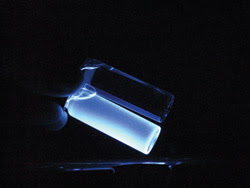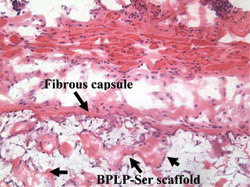
Creating a healthy glow
Noninvasive visualization of cancerous tissue and tumors has long been a goal of many medical researchers. In their drive to make it a reality, investigators have developed biodegradable polymers that can carry fluorescent quantum dots or organic dyes into tumors for imaging purposes.
These agents can be quite toxic, however, and their fluorescence can deteriorate over time, making them unsuitable for long-term examination of cells in vivo. Attempts to alter their surface or to coat them to prevent cell death have not yet proved safe enough to use in human subjects.

The biocompatible polymers fluoresce brightly.
To combat these drawbacks, investigators in the bioengineering department at the University of Texas and from the University of Texas Southwestern Medical Center in Dallas have reported a series of biocompatible and biodegradable fluorescent polymers. As with similar substances, they can be used both as implant materials and as bioimaging agents – and could be used as a temporary template to guide tissue regeneration. However, these new polymers, synthesized from monomers such as citric acid and various amino acids, also can emit in vivo detectable fluorescence without the risk of deterioration or toxicity.
“None of the previous biodegradable polymers can function as both implant materials and as in vivo bioimaging probes,” said Jian Yang, lead author of the study. Their glow results from a six-member ester-amide ring structure, which could enable doctors to track clinical outcomes without invasive surgery.
The biodegradable photoluminescent polymers (BPLPs) are low-molecular-weight aliphatic oligomers that can be water-soluble or -insoluble. Through further processing, they can form elastomeric cross-linked BPLPs, which demonstrate tunable fluorescence emission ranging from blue to red.

Polymer scaffolds were implanted into nude mice and examined at 100× magnification after five months. The samples did not show edema or cell death but did demonstrate the development of a fibrous capsule, a mild inflammatory response. Images courtesy of Jian Yang.
To test the biocompatibility of the polymers, the researchers inserted both nanoparticles and scaffolds made from the materials into nude mice. The fluorescence from both structures was detectable in vivo through noninvasive imaging, and the animals showed only a mild inflammatory response after living with the insertions for five months.
The scientists are working to create drug-loaded nanoparticles from the polymers. The particles would target tumors or cancer cells and release the drugs to treat them, enabling doctors to see the location and size of the tumors.
Yang said that the group is interested in using the materials for the regeneration of tissues and organs and to create biodegradable stents, orthopedic fixation devices and other biomedical devices.
Published: September 2009